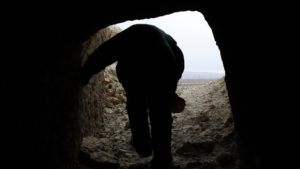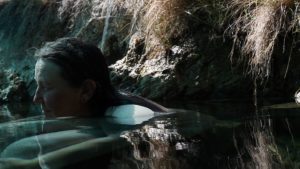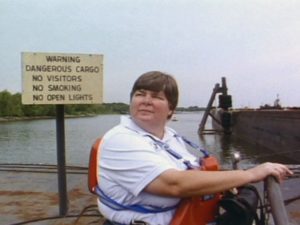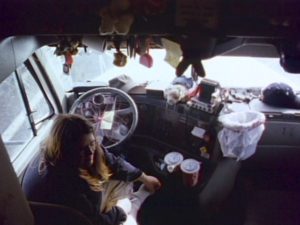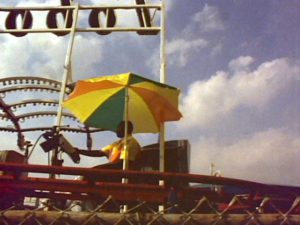An Evening with Brigid McCaffrey at the HFA showcased three of the emerging filmmaker’s recent works: Castaic Lake, Paradise Springs, and Bad Mama, Who Cares. Each is stylistically quite different from the next; indeed, in the post-screening Q&A, McCaffrey described her process as at least partly consisting of growing sick of current projects and using that feeling to generate inspiration for new ones.
In Castaic Lake, McCaffrey has chosen as location a popular recreation spot in northwestern Los Angeles County. The surrounding environment seems exceedingly dry – apart from the lake itself – but nevertheless it bustles with activity at some of its shores. Central to the film’s energy is McCaffrey’s careful surveying of the landscape; she scans over sunlit picnic tables, sleeping visitors, and the composition of rocks that surround the reservoir. She seems to operate by the practice of shooting first and asking questions later.
Brief interview footage crops up every now and again; the interviewees don’t appear to share much in common other than their choice of recreation, though even this differs, as one is an employee of the area (and thus hasn’t necessarily ‘chosen’ in the same sense as visitors). He recounts the story of a 12-year-old’s drowning on his watch solemnly but without faltering. One of the most engrossing shots of the film – an observation echoed by the Q&A moderator David Pendleton – takes place while the employee continues on about the nature of his work: the camera cuts to the shore, slowly, and rather hauntingly, pulling away from it to reveal a wider picture. We’re left to contemplate an array of things; perhaps the violence and volatility of nature, or our relationship to it, or the many other stories, and tragedies, that this body of water may hold.
Paradise Springs positions Ren Lallatin, a geologist, as its central and only character, apart from a brief instance in which McCaffrey enters the frame (when Ren needs help cutting her hair). We’re taken to a much more sprawling and endless landscape, of the Mojave Desert and other picturesque settings of the American West, compared to the boundedness of Castaic Lake by mountain on all sides. These large expanses become shaped by the astute and somewhat poetic worldview of Ren. In this film McCaffrey explores what she termed in the Q&A as “geologic time,” and combined with what is elicited from Ren, and the ease and comfort Ren obviously feels in this environment – characterized by volatile, unpredictable geological activity as it is – we glean something fundamentally transitory and ephemeral, yet powerfully meaningful and transcendent, about human existence.
Ren’s articulate observations about life give the film a sentimental tone. Though not much detail is given on her own life and experiences, she does share that she had a difficult childhood and references her transitory status at this point in time, staying in places only three or four days at a time – it seems that her car, packed with resources and supplies, is her most reliable source of refuge. Far from feeling frustrated about this state of affairs – or, perhaps, choosing not to express that side to McCaffrey and the camera – she muses thoughtfully on the “European concept of the ownership of land.” Against the backdrop of an environment that, according to geologic time, is in flux, we come to ponder land ownership as rather preposterous, considering our insignificant control over land when all is said and done.
Paradise Springs shows a number of idyllic, remote landscapes, like the springs where Ren bathes and shares a cosmological perspective on aging. But the film also portrays nature’s unforgiving side in shots of bare desert, with the camera situated high enough to obscure the horizon, and a degree of brightness that is almost blinding, compared to the other two films.
Framed by frustrations over housing situations, as McCaffrey explained in the Q&A, Bad Mama, Who Cares takes a much closer look at Ren’s psychology, in a sense, as well as the material circumstances under which she lives. Much of this 11-minute film is made up of close ups of Ren’s face while some kind of image distortion – produced by a double exposure, I would guess – guides the degree of motion and activity in the frame. In one of these shots, multiple sets of Ren’s eyes wander in various directions. In another, the frame is divided into an X-like shape; the top part of the X is Ren, while on the sides, McCaffrey slowly glides across train tracks. The sense of McCaffrey-as-surveyor is vividly maintained, despite the film’s more experimental composition and the way in which images are altered to confuse or disorient.
These three films are, overall, an intuitive blend of cinematic texture and investigation in a way that made them seem very personal, while also doubting or questioning the foundations of time, space, and memory on which the very ideas of personhood and humanity are built. They dig into the essence of the natural and the human, probing the connection between the two. Their deeply atmospheric quality lulled me into a contemplative state because, through the juxtaposition between human intellect/thought and the instability of nature, the films began to chip away at the notion that being human is to be any one thing in particular. The random assortment of variables and contradictions that constitute the chaos of nature also construct human sensibility; we can’t claim to have an origin any less chaotic or happenstance as the environments and geological structures that shape our land. It’s the kind of attitude that propels exploration and repels superficiality, an altogether uplifting set of aspirations.
On Wednesday, Lay Down Tracks, a 61 minute collaboration with fellow filmmaker Danielle Lombardi, screened at the MassArt Film Society, which has been led by the programming efforts of Saul Levine for a number of decades. It was my first time attending a screening organized by this self-described “microcinema” and, despite some audio/technical difficulties that delayed its start time, the intimacy of the event gave me a sense of community that I don’t necessarily feel at other film events in Boston.
Lay Down Tracks is most obviously different from McCaffrey’s three films that screened on Monday by its change of location to the east coast, its collaborative nature, and its lack of expansive, empty landscapes. Like Castaic Lake and Bad Mama, Who Cares, it’s shot in 16mm. In general there is a lot more “stuff” that clutters the screen in Lay Down Tracks, from a port crowded with ships navigating around each other, to the cramped living quarters of a female trucker, to the overwhelming sights and sounds of a carnival. In no way did this sense of clutter take away from the film’s central interests or its drive to capture a kind of unseen culture that bristles with energy in America; rather, it was a worthy contrast, showing the range of environments under which McCaffrey can be at ease with a camera.
Lay Down Tracks doesn’t so much have a storyline as it has a meandering sense of purpose. Its characters are all travelers in one way or another: the female trucker travels on the road while another woman travels by sea; one young man hops from country to country with his surfboard in tow – providing 8mm footage of his travels that appear in short segments – while an older man ventures by train. A retired carnival worker seems nostalgic about a way of life which he once inhabited and which moved much more rapidly, like those of the other characters, but mostly shares his perspective from the comfort of home. The film makes no direct comparison between modes of transportation but it’s easy to think about their distinct characteristics while we listen to these travelers recounting the ups and down of life on the road, the wisdoms they’ve gained from it, and the beliefs that have stayed with them throughout constantly changing environments.
Lay Down Tracks has a dream-like quality to it in its shifting perspectives and locations, as well as the warm, sometimes glowing aesthetic provided by 16mm film. After the screening one audience member described the filmmaking style as an organic one, wherein the presence of the filmmaker is barely detected. To me it didn’t necessarily feel that way, and McCaffrey also indicated that she felt differently, though presumably for different reasons. Lay Down Tracks seems to share that kind of probing, surveying approach that Castaic Lake and Paradise Springs have, but much more dialogue is elicited; in fact, there is almost continuous audio from interviews, which were recorded separately from the visual footage (per the constraints of 16mm film). There was much less silence in general, but its pacing still maintained a kind of patience that lets us sit with images, like colorful shots of trees whose leaves have turned bright reds and yellows, on which the camera lingers, or rain falling against a windshield – a dark grey sky in the horizon – and being quickly swept away by windshield wipers. Seasonal change is certainly a distinct aspect of Lay Down Tracks that’s absent from McCaffrey’s California films. This departure at least partly accounts for the heightened degree of movement and clutter; the link between seasonal change and time is that the one speeds the other up, making time seem compressed, shaped by a regenerative energy that ushers in the new and unexpected. Perhaps this is where the film’s travelers find solace. Perhaps this is what propels them for the unpredictable kind of life that being on the road entails.
In Castaic Lake, Paradise Springs, and Bad Mama, Who Cares, McCaffrey seems to grapple with that familiar struggle to remain in the moment, to appreciate what’s in the frame rather than wondering about what’s elsewhere, or pondering ideas that are out of our immediate grasp. But in Lay Down Tracks it is precisely this obsession that makes the film what it is, providing its creative energy and direction. Even something as simple as hearing its characters speak while the camera shows some other activity, or scans some other object of interest for us to observe, involves some work on the part of our imagination to forge a connection between the two.
And being on the road is a constant state of being ‘elsewhere,’ of not being able to focus on the moment but rather where you’ll end up next, and when you might return home. Even homecoming is a bittersweet reality – the railroad executive recounts a sort of ritual upon his return visits, in which his wife presents obituaries from the paper featuring friends of theirs who have died in his absence. There is something lost in being away from home, but there’s also something else found in it. Loss and renewal strike a sort of balance with one another, much like the changing of seasons when one cycle ends and a new one begins.
I took a profound sense of inspiration away from these screenings, in part because when I envision the kinds of films I’d like to make – if/when I start making films of my own – I see something very much like McCaffrey’s films, in terms of both aesthetic and thematic qualities. The idea of working with 16mm film has also been a growing one on my mind, purely because I’ve thought: why the hell not? It didn’t occur to me until, during the Q&A following Lay Down Tracks, when an audience member tried to figure out why McCaffrey would make such a choice, that it could be a deterrent for viewers. There would have to be some concrete reason, some identifiable end to be achieved, to choose 16mm and return to something that’s no longer used, they explained. I was struck by how little I’ve even thought about it, and I’m not sure if it’s a debate that really interests me. Instead I’m compelled by the fact that when independent filmmaking started to blossom in the 50s, 60s, and 70s and people started making radically different kinds of films than had ever been made before, they had to jerry-rig their filmmaking equipment much of the time, figuring out on the spot how to make things work. Using 16mm film today seems like a way to recognize and honor that history, perhaps. But with the advent of more sophisticated digital technology, maybe this viewer had a point.
Apart from my own feelings of inspiration, McCaffrey’s approachable presence made these kinds of questions easy to ask. She exhibited a kind of laid-back attitude that made me imagine that it’s quite easy for her to be comfortable filming in the field, meeting people and making new connections on the fly. I’m particularly appreciative of her interest – at least, an interest I took away from listening to these Q&As – in portraying the stories and struggles of women through film. Combined with her artistic focus and process, I look forward to her work in the future.


